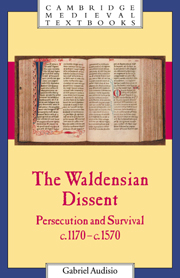Book contents
- Frontmatter
- Contents
- List of maps
- Preface
- Acknowledgements
- Introduction
- 1 1170 – 1215: decisive and purposive origins
- 2 The thirteenth century: the need to adapt
- 3 The fourteenth century: the challenge of believing differently
- 4 The fifteenth century: the risks of longevity
- 5 The constraints of a life in hiding
- 6 The need to organise
- 7 A culture of their own: the written and the spoken word
- 8 The sixteenth century: the end as a way forward?
- 9 Epilogue: the Waldensian Church
- Conclusion
- Bibilography
- Index
- Cambridge Medieval Textbooks
9 - Epilogue: the Waldensian Church
Published online by Cambridge University Press: 05 June 2012
- Frontmatter
- Contents
- List of maps
- Preface
- Acknowledgements
- Introduction
- 1 1170 – 1215: decisive and purposive origins
- 2 The thirteenth century: the need to adapt
- 3 The fourteenth century: the challenge of believing differently
- 4 The fifteenth century: the risks of longevity
- 5 The constraints of a life in hiding
- 6 The need to organise
- 7 A culture of their own: the written and the spoken word
- 8 The sixteenth century: the end as a way forward?
- 9 Epilogue: the Waldensian Church
- Conclusion
- Bibilography
- Index
- Cambridge Medieval Textbooks
Summary
Strictly speaking, the previous chapter narrated the end of the history of the Poor of Lyons and of Waldensiamsm. The reader should indeed have no reason to doubt that, by becoming Protestants, the Waldensians apparently preserved nothing of their former originality. Their religious sensibility became a dogma; what had amounted to a clandestine attachment to the Word of God, passed down through the generations within the family, developed into a means to propagate the gospel, which was at least what its destiny should have been; what was once a cluster of believers, tried and cherished by God, became a Church offering an alternative path to salvation in defiance of the Roman Church. The Waldensians' characteristic attachment to poverty, which had set them apart from their peers, was abandoned. In the west, the barbes represented both the frame and the lifeblood of the movement, despite its geographical fragmentation. Their importance, which had not escaped the inquisitors who questioned suspects directly on the matter, was such that the surest criterion by which to judge whether someone belonged to the sect was to establish whether he welcomed a preacher into his house. Until recent times, the inhabitants of the Waldensian valleys were indeed dubbed ‘barbets’ by their fellow Catholics in Piedmont. The Poor of Lyons were those who supported the barbes. On a practical level, as far as the community's organisation was concerned, when the bearers of the Word, mendicant and unmarried, gave up their itinerant preaching mission, it amounted to bringing Waldensiamsm itself to a close.
- Type
- Chapter
- Information
- The Waldensian DissentPersecution and Survival, c.1170–c.1570, pp. 189 - 214Publisher: Cambridge University PressPrint publication year: 1999



